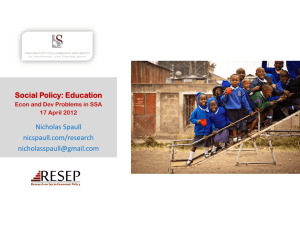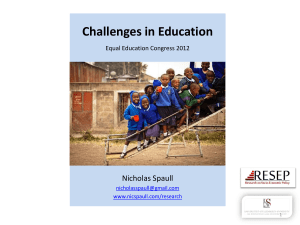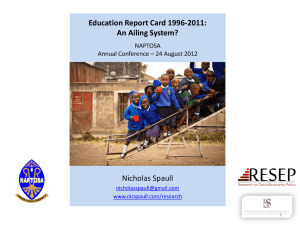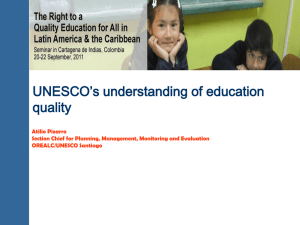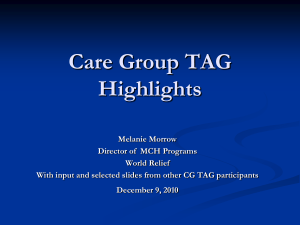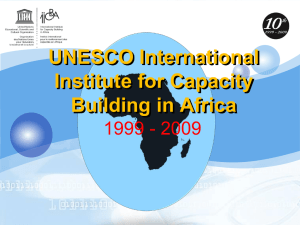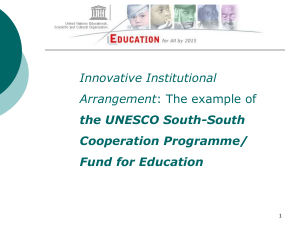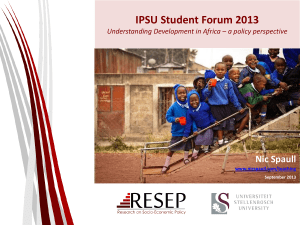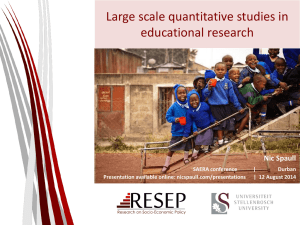Presentation
advertisement
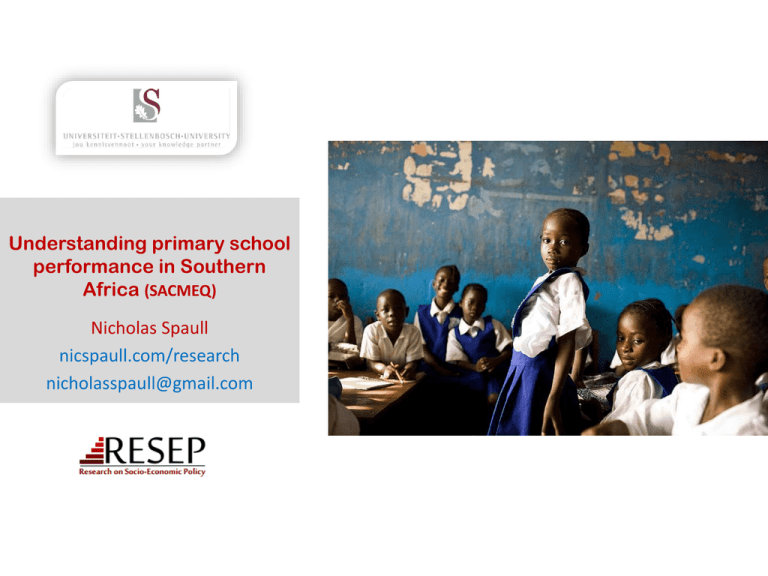
Understanding primary school performance in Southern Africa (SACMEQ) Nicholas Spaull nicspaull.com/research nicholasspaull@gmail.com Background: Data SACMEQ Southern and Eastern African Consortium for Monitoring Educational Quality 14 participating countries SACMEQ II (2000), SACMEQ III (2007) Background survey Testing : o Gr 6 Numeracy o Gr 6 Literacy o HIV/AIDS Health knowledge SACMEQ: South Africa 9071 Grade 6 students 1163 Grade 6 teachers 392 primary schools Distribution of student performance SA in regional context WCA LIM Looking specifically at South Africa South Africa: Socioeconomic breakdown SA Bimodality – fact, no longer theory Language PIRLS Gr 5 (Shepherd, 2011) .001 .015 .01 .005 .002 Density .003 .004 .02 .005 .025 Ex-Department NSES Gr 4 (Taylor, 2011) 0 0 Two education systems not one 0 400 reading test score 20 800 40 60 Numeracy score 2008 Ex-DET/Homelands schools English/Afrikaans schools 80 100 Historically white schools 0 Socioeconomic status SACMEQ Gr 6 (Spaull, 2011) .0 04 .0 06 .0 08 African language schools 600 .0 02 200 D en sity 0 0 200 400 600 Learner Reading Score 800 Poorest 25% Second poorest 25% Second wealthiest 25% Wealthiest 25% 1000 Regional comparisons SA in regional context Public Current expenditure on Country Total population Adult literacy (mil) rate Net Enrolment Rate (2008) GNP/cap PPP primary education per pupil (unit US$ (2008) cost) 2007 – [PPP constant 2006 US$] Survival rate to Grade 5: school year ending 2007 Botswana 1.92 83% 87% 13100 1228 89%3 Mozambique 22.38 54% 80% 770 792 60% Namibia 2.13 88% 89% 6270 668 87%3 South Africa 49.67 89% 87% 9780 1225 98% (UNESCO, 2011) (UNESCO, 2011) (UNESCO, 2011) (UNESCO, 2011) (UIS, 2009) (UNESCO, 2011) Source SACMEQ III (2007) Self-reported teacher absenteeism Proportion of Grade 6 students functionally illiterate Proportion of Grade 6 students functionally innumerate Proportion of students Proportion of students with own reading with own mathematics textbook textbook Botswana 10.6 days 10.62% 22.48% 63% 62% Mozambique 6.4 days 21.51% 32.73% 53% 52% Namibia 9.4 days 13.63% 47.69% 32% 32% South Africa 19.4 days 27.26% 40.17% 45% 36% Textbooks Resources the issue? More reading textbooks More maths textbooks Questions, conclusions & recommendations Questions 1. How is it possible that more Mozambican students have access to their own textbooks than SA students, and this when SA spends 15 times as much per child than Mozambique? (workbook delivery?) 2. How is possible that Limpopo performs worse than all 40 other provinces in SA/Namibia/Botswana/Mozambique? 3. Why is it acceptable in South Africa for teachers to be absent (unjustifiably) for an entire month? 4. Do we really know what is wrong with our system? If so, why has it taken so long to fix it? • LOLT? Unions? Teacher training? Conclusions • Speaking of a single education system in SA is a misnomer – the average South African student does not exist in any meaningful sense. Bimodality is a fact. • South Africa is not able to convert material advantage into cognitive skills Low quality education Low social mobility Hereditary poverty Highly inefficient • While the survey was conducted in 2007, and things may have changed, the outcomes certainly haven’t (see ANA’s, 2011; and (?) PIRLS/TIMSS 2012) More of the same? Serious blight on the national conscience Persistent patterns of poverty and privilege Recommendations 1. Acknowledge the extent of the problem • Low quality education is one of the three largest crises facing our country (along with HIV/AIDS and unemployment) 2. Experiment to figure out what works • More of the same hasn’t worked Need to try new things and rigorously evaluate them to see what works. – Workbooks & ANA’s are a positive sign – Failed programmes provide useful information when acknowledged & disseminated. 3. Increase accountability, information & transparency • Where is the money going? • Deal ruthlessly with corruption – this is a social crime. • For at least one grade (Gr6?) get ANA externally validated by an independent body like Umalusi and get this information to parents need to empower parents with information in an accessible format Thank you www.nicspaull.com/research nicholasspaull@gmail.com @NicSpaull

